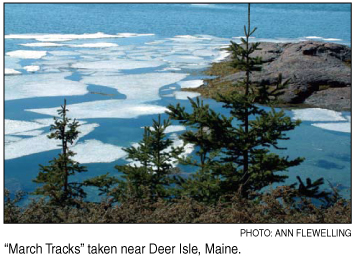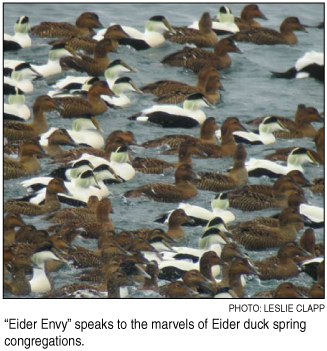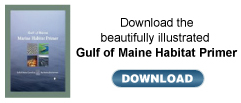Editor's Notes
Enjoying the spring melt
It’s between seasons, the melt, when the awkward
silence encapsulating nature in ice is orchestrated into a crescendo
of buds overgrowing brown stick plants and lush green shoots carpeting
mudflats. Birds return like clockwork every year, and animals
come out of their slumber to seek food and mates.
It’s a time of year when warming air and longer daylight
lure humans to the outdoors as well.
 This Winter/Spring issue of the Gulf of Maine Times celebrates the melt in two stories. Assistant editor Catherine
Coletti takes us to a marsh in winter, and tells us of the impending
changes. “During winter, most of the perennial plants—the
plants that will come back each spring—use energy and nutrients
absorbed by their rhizomes, or underground plant stems, to stay
alive under the ice,” she writes. This Winter/Spring issue of the Gulf of Maine Times celebrates the melt in two stories. Assistant editor Catherine
Coletti takes us to a marsh in winter, and tells us of the impending
changes. “During winter, most of the perennial plants—the
plants that will come back each spring—use energy and nutrients
absorbed by their rhizomes, or underground plant stems, to stay
alive under the ice,” she writes.
“This spring, increasing light and warmth will tell the
marsh to wake up...the melting away may reveal a weathered face,
as ice, tides and waves have chipped away at its fragile outer
edges.”
Another story profiles poet and conservationist Marnie Reed
Crowell, a resident of Deer Isle, Maine. Nothing tickles Crowell’s
imagination like the spring melt. At the first signs of cracking
ice, images flood her mind and poetry runs through her fingertips
onto paper. The biologist-cum-poet and environment conservationist
says every season has its charms, but she loves melt. “I
like to watch new sprouts come up and the old, dirty snow melt
away … increasing day(light) is a metaphor for optimism,”
says Crowell.
She describes the energy of the melt we’re all about to
experience beautifully in “Eider Envy,” her poem
about the Eider duck spring congregations that she calls “one
of the wonders of the natural world.”
“Was it yesterday the frozen cove
was locked-down desert? Today
the shore is ringed with rotting
blocky slabs.
In a languid band of Prussian blue
the rockweeds
wave and the silver sheen is alive
with thousands of eiders. It’s galactic,
this black-and-white sprinkle.” |
 |
The melt is a time of year that calls amateur and expert naturalists
alike to observe the rebirth of the world around them—the
lichens rimming the bottom of tree trunks in the city and country,
the bird song returned after a long winter, buds spiraling around
tree branches. Whether you experience these awakenings on your
own or as part of a group outing, enjoy.
Lori Valigra
|








